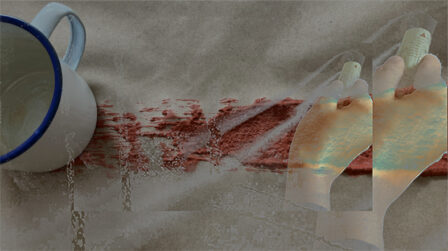Drawing a line

On 8 July, artist in residence Nana Shimomura presents Drawing a line at Hangar, an experimental performance exploring action and intention by Nana, who researches Asian calligraphy, and dancer Julián Rico Engel.
The act of drawing a line can be controlled by one’s intention.
In this performance, the creation of a single line takes place in an unpredictable context where the actions and intentions of two individuals intertwine, leading to the deconstruction of perspectives on what has been written.
The single line produced in this performance is not simply the creation of one person, but the result of a collaboration between two individuals. However, the completed line itself remains singular. The work explores the contrast between the act of creation and the resulting entity.
Through this performance we visualise the following aspects:
– Sharing the time it takes to write
– Sharing what is written as traces of movement
– Observing the process of trace formation
It is generally accepted that written works and drawings exist as finished creations.
They contain more than just meaning; they also contain the following elements
– The time taken to write them
– The speed at which it was written
– The movements of the creator in the act of writing.
The aim of this performance is to perceive what is written as traces of different intentions and actions. By creating a single line through the intentions and actions of two individuals, we analyse how sound and dance, similar to calligraphy, encompass the act of “writing” from a contemporary perspective.
Why do we focus on traces? It is because the present culture is built upon the accumulation of traces left by our ancestors in the distant past. The forms of characters we use, such as kanji and alphabets, have evolved through various changes in their written shapes, including pictographic and oracle bone script. Similarly, the shape of a cup for drinking water has been influenced by the traces of human actions from the past, leading to its current form.
Calligraphy is not just a traditional cultural expression. It is a relic of the past, born of our impulse to express ourselves through “writing”. The word “kaku” (writing) is homophonic with the words “drawing” and “scratching”. I believe that the act of “kaku”, like music and dance, represents the purest form of creativity that comes from our ancient impulses. Calligraphy represents not only the concept of “writing” but also the traces of communication in a pre-literate society. By delving into the act rooted in “kaku”, we aim to present calligraphy as a concept that exists as an extension of basic human behaviour, transcending the differences between Eastern and Western cultures.
Practical information
Day: July 8th
Time: 5 pm
Place: Sala Ricson, Hangar
Free entrance
Nana Shimomura is a grantee of the Pola Foundation for the Promotion of Visual Arts in Japan.

Categories: Agenda Hangar |
